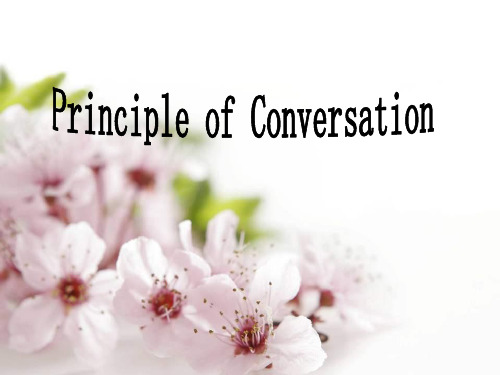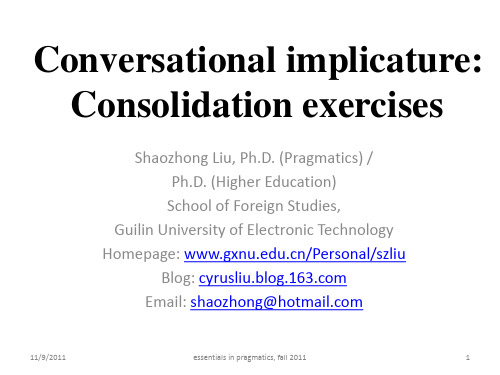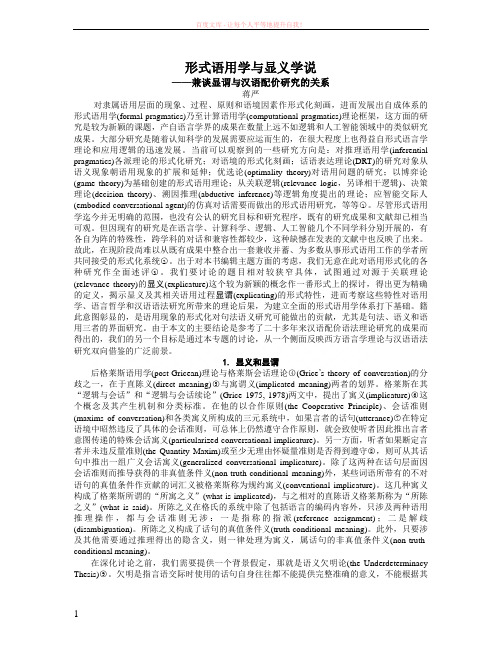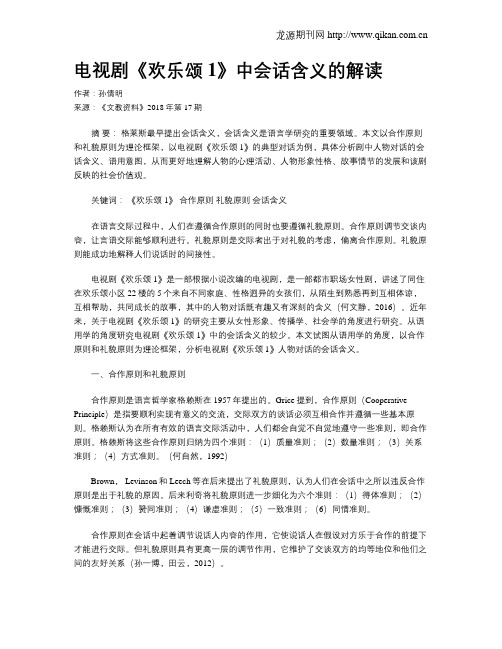Generalized and Particularized____ Implicatures
- 格式:ppt
- 大小:96.00 KB
- 文档页数:22




会话含义与合作原则美国语言哲学家格赖斯为了保证谈话顺利进行,谈话双方必须共同遵守一些准则,特别是在1967年提出的“合作原则”。
当谈话一方不遵守合作原则而又不是为了说谎为目的即故意违反准则,于是就产生会话含义。
会话含义就是一种超出语句本身意义范围的意义,即说话者的“言外之意”。
一般来说,人们可以通过违反合作原则中的质、量、关系原则和利用方式准则来表达或推导出会话含义,来表达与字面意思不同的没有说出来的含义,回避志杰说出想表达的意思,含蓄的表达自己的真实意图。
会话含义一般可以分为两类:一般含义和特殊含义。
一般含义是指在遵守合作原则中的默想准则是带有的含义。
特殊含义是指在有意违反合作原则中的某项原则,在特定的语境中推导出来的含义。
会话含义的特征可以归纳为:可取消性、不可分离性、可推导性、非规约性和不确定性。
概要:一、会话含义的由来二、合作原则的几项原则:质的原则量的原则关系原则礼貌原则三、会话含义的产生方法:违反质的原则:故意提供不足的信息,提供没有必要的信息违反量的原则:说一些不符合事实的话;说一些荒唐的话违反关系原则利用礼貌原则:使用有歧义的词语:使用不必要的词语;打乱叙述顺序四、会话含义的种类:一般会话含义和特殊会话含义五、会话含义的特点:可取消性、不可分离性、可推导性、非规约性和不确定性关键词:会话含义合作原则违反谈话C onversational Implicature and Cooperative PrincipleAmerican linguistics H.P.Grice once gave in 1967.In the speech, Grice said, the two sides of the conversation must obey some basic rules, especially the “cooperative principle”, to ensure that the conversation can go on propitiously. When one side of the principle doesn’t want to lie, conversational implicature comes out. Conversational implicature is a kind of meaning, which is beyond the sentence itself. Generally speaking, people can violate the maxim of quality, quantity, and relation and use the maxim of the manner to produce conversational implicature, which send the unsaid meaning of the words. Generally speaking, conversational implicature can be divided into two kinds: generalized implicature and particularized implicature. Generalized implcature refers to an implicature, which obeys the cooperative principle and also has the meaning. Particularized implicature refers to the implicature that violates some of the cooperative principle and makes the meaning in some specially context. The features of the conversational implicature: cancelability, no detachability, calculability, non-conventionality and indeterminacy:Key words:Conversational implicature cooperative principle violate conversationC onversational Implicature and Cooperative PrincipleAmerican linguistics H.P.Grice once gave speeches in 1967.In the speech. Grice said, the two sides of the conversation must obey some basic rules, especially the “cooperative principle”,to ensure that the conversation can go on propitiously. He believed the two sides of the conversation should have a same wish: the two sides can understand each other. So both of them obey some cooperative principles to achieve the aim. However, Grice said, not all the people in the conversation obey the rules. Once one side finds the other side not obey the cooperative principle, he will make himself try his best to understand the unsaid meaning in the conversation. So the conversational implicature comes out.As the conversational implicature has a close relationship with the co operational principle, we will introduce the cooperative principle first. In a conversation, the participants must first of all be willing to cooperate;Otherwise, it would not be possible for them to carry on the talk. This general principle is called the cooperative principle.There are four main maxims in the cooperative principle:●The maxim of quality: make your contribution as informative as required(for thecurrent purpose of the exchange);Do not make your contribution more informative than is required.●The maxim of quality: do not say what you believe to be false; do not say that forwhich you back adequate evidence.●The maxim of relation: the words have a relationship with other factors.The maxim of manner: avoid obscurity of expression; avoid ambiguity; be brief (avoid unnecessary prolixity); be orderly.The conversational implicature is a meaning out of the sentence itself; it is the speaker’s meaning under the literal. In the real life, people often violate some principles to sent some dark meaning.The meaning related with the cooperative principle may become by the following ways:First, to violate the maxim of quality1.Offer the deficient information on purpose.E.g.:One farmer meets Sam and says:“Hey, Sam, my horse’s got distemper. What did you give yours hen he had it?”“Turpentine,” grunted Sam.A week later they meet again and the first farmer shouts:“Sam, I gave my horse turpentine like you said and it killed him.”“S o did mine.” nodded Sam.第一位农妇的真正目的不仅是向Sam了解马病用了什么药,而且想了解治疗的结果,但通过对话它实际上只达到了一半的目标。

形式语用学与显义学说——兼谈显谓与汉语配价研究的关系蒋严对隶属语用层面的现象、过程、原则和语境因素作形式化刻画,进而发展出自成体系的形式语用学(formal pragmatics)乃至计算语用学(computational pragmatics)理论框架,这方面的研究是较为新颖的课题,产自语言学界的成果在数量上远不如逻辑和人工智能领域中的类似研究成果。
大部分研究是随着认知科学的发展需要应运而生的,在很大程度上也得益自形式语言学理论和应用逻辑的迅速发展。
当前可以观察到的一些研究方向是:对推理语用学(inferential pragmatics)各派理论的形式化研究;对语境的形式化刻画;话语表达理论(DRT)的研究对象从语义现象朝语用现象的扩展和延伸;优选论(optimality theory)对语用问题的研究;以博弈论(game theory)为基础创建的形式语用理论;从关联逻辑(relevance logic,另译相干逻辑)、决策理论(decision theory)、溯因推理(abductive inference)等逻辑角度提出的理论;应智能交际人(embodied conversational agent)的仿真对话需要而做出的形式语用研究,等等○1。
尽管形式语用学迄今并无明确的范围,也没有公认的研究目标和研究程序,既有的研究成果和文献却已相当可观。
但因现有的研究是在语言学、计算科学、逻辑、人工智能几个不同学科分别开展的,有各自为阵的特殊性,跨学科的对话和兼容性都较少,这种缺憾在发表的文献中也反映了出来。
故此,在现阶段尚难以从既有成果中整合出一套兼收并蓄、为多数从事形式语用工作的学者所共同接受的形式化系统○2。
出于对本书编辑主题方面的考虑,我们无意在此对语用形式化的各种研究作全面述评○3。
我们要讨论的题目相对较狭窄具体,试图通过对源于关联理论(relevance theory)的显义(explicature)这个较为新颖的概念作一番形式上的探讨,得出更为精确的定义,揭示显义及其相关语用过程显谓(explicating)的形式特性,进而考察这些特性对语用学、语言哲学和汉语语法研究所带来的理论后果,为建立全面的形式语用学体系打下基础。

电视剧《欢乐颂1》中会话含义的解读作者:孙倩明来源:《文教资料》2018年第17期摘要:格莱斯最早提出会话含义,会话含义是语言学研究的重要领域。
本文以合作原则和礼貌原则为理论框架,以电视剧《欢乐颂1》的典型对话为例,具体分析剧中人物对话的会话含义、语用意图,从而更好地理解人物的心理活动、人物形象性格、故事情节的发展和该剧反映的社会价值观。
关键词:《欢乐颂1》合作原则礼貌原则会话含义在语言交际过程中,人们在遵循合作原则的同时也要遵循礼貌原则。
合作原则调节交谈内容,让言语交际能够顺利进行。
礼貌原则是交际者出于对礼貌的考虑,偏离合作原则。
礼貌原则能成功地解释人们说话时的间接性。
电视剧《欢乐颂1》是一部根据小说改编的电视剧,是一部都市职场女性剧,讲述了同住在欢乐颂小区22楼的5个来自不同家庭、性格迥异的女孩们,从陌生到熟悉再到互相体谅,互相帮助,共同成长的故事,其中的人物对话既有趣又有深刻的含义(何文静,2016)。
近年来,关于电视剧《欢乐颂1》的研究主要从女性形象、传播学、社会学的角度进行研究。
从语用学的角度研究电视剧《欢乐颂1》中的会话含义的较少。
本文试图从语用学的角度,以合作原则和礼貌原则为理论框架,分析电视剧《欢乐颂1》人物对话的会话含义。
一、合作原则和礼貌原则合作原则是语言哲学家格赖斯在1957年提出的。
Grice提到,合作原则(Cooperative Principle)是指要顺利实现有意义的交流,交际双方的谈话必须互相合作并遵循一些基本原则。
格赖斯认为在所有有效的语言交际活动中,人们都会自觉不自觉地遵守一些准则,即合作原则。
格赖斯将这些合作原则归纳为四个准则:(1)质量准则;(2)数量准则;(3)关系准则;(4)方式准则。
(何自然,1992)Brown, Levinson和Leech等在后来提出了礼貌原则,认为人们在会话中之所以违反合作原则是出于礼貌的原因。
后来利奇将礼貌原则进一步细化为六个准则:(1)得体准则;(2)慷慨准则;(3)赞同准则;(4)谦虚准则;(5)一致准则;(6)同情准则。
会话含义与礼貌原则摘要:礼貌是交际成功的前提,在交际中起重要作用。
合作是话语参与者都应遵守的原则。
会话含义来源于合作原则,会话含义的产生在交际中与礼貌有密切的联系。
本文首先叙述了会话含义理论,对会话含义中的“归约性”和“非规约性”的概念进行了区分,探讨了合作原则和会话含义之间的关系,其次借助lakoff和leech 的礼貌原则对礼貌这一交际中的语用现象进行了对比,最后探讨了礼貌原则的使用和合作原则违反对会话含义的产生带来的影响。
关键词:礼貌原则合作原则会话含义1.引言会话含义是指说话人话语意思的暗含(implying)及听话人对其所(隐)含意思(what is implied)的理解。
格赖斯(grice)的合作原则(cooperative principle)是会话含义理论的基础。
格赖斯认为,这里合作的概念是:会话参与者尽管是分别提供自己的话语,但总是在一定程度上意识到其中的某一目的,至少是一个相互都能接受的话语发展方向;这一(些)目的或方向的达成是会话参与者在交流过程中共同合作努力的结果。
也可以说是在会话过程中共同维护和坚持当前的目的和方向形成的默契(grice,1975)。
礼貌原则是以说话人为中心的一种社会学原则。
lakoff(1973)认为在某些类型的言语交际中,礼貌因素在决定会话的有效性上占上风。
lakoff(1973)指出礼貌受三条规则支配:不要强加;给予人选择的机会;友好相待。
lakoff(1977)提出了“语用能力”两条原则:清楚和礼貌,她认为其中的清楚原则主要针对信息,大致等于grice的“合作原则”。
礼貌原则由以下三个规则构成:(1)拘泥性:不要强加,保持距离;(2)犹豫,给听者选择;(3)平等或同志般的友情。
笔者从格赖斯的会话含义角度对礼貌原则及礼貌的使用进行分析,论述合作原则与礼貌原则之间存在的必然联系。
2.会话含义会话含义(conversational implicature)最初是美国语言哲学家格赖斯于1967年提出来的。
第七章语用学•美国哲学家C.Morris(1946)把符号学分成三大部分:•句法学---研究语言符号和符号之间的关系;•语义学---研究语言符号和世界对应体之间的关系;•语用学---(pragmatics)研究语言符号和符号使用者之间的关系。
•此前,逻辑学家R.Carnap(1938)认为语用学探讨的是“人生成和理解语言符号的行为、状态和场合”上,使得部分分析哲学家、语言学家、人类学家、社会学家、心理学家消极地把语用学定义成应付“语义学无法处理的内容”的学科,语用学便似乎成了什么都可以往里扔的“废纸篓”了。
•我们认为,语用学探讨的是符号产生交际意图的规律,词语意义和语境结合可以产生语用意义,因此语用学所探讨的对象,应该是语用者解码和推理的规律,即把符号和语境结合,通过推理去理解说话人意图的过程。
•研究类似规律的语用学理论包括:•(1)言语行为的适宜条件(felicity conditions.J.Austin1962,J.Searle1969),•(2)会话公设(conversational postulates.D.Gordan&koff1975),•(3)善行原则(principle of charity.D.Davidson1972, 1980),•(4)合作原则和会话准则(cooperative principle and conversational maxims.P.Grice1975),•(5)理性原则(principle of rationality.A.Kasher1976),•(6)悲观互动策略(strategy of interactional pessimism.W.Labov&D.Fanshel1977,S.Levinson1983),•(7)透明原则(principle of transparency.M.Dascal1983),•(8)礼貌原则(politeness principle.G.Leech1983,P.Brown &S.Levinson1987),•(9)关联原则(principle of relevance.D.Sperber&D.Wilson1986)等。